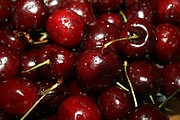‘What cherry harvest?’
ROYAL CITY — There are short and long crops in the tree fruit business, good and bad years, and then there are those years, those harvests, the ones few growers - if any - remember fondly. The 2022 Pacific Northwest cherry harvest may be one of those.
“What cherry harvest?” said Luke Tonnemaker of Tonnemaker Hill Farm, near Royal City.
Tonnemaker said the 2022 crop at the Tonnemaker farm was about 5% or less of a normal crop. Drew Bolton, production manager for the Chelan Fresh cooperative based in Chelan, said the company’s crop was about 50% of what growers hoped.
Wenatchee-area orchardist Norm Gutzweiler said his crop was much lighter than anticipated. He said he’s luckier than some of his neighbors though.
“Many people in our area were not able to pick anything at all,” Gutzweiler said. “From that standpoint, I feel blessed. We do have some that we can harvest.”
B.J. Thurlby, president of Northwest Cherry Growers, said the 2022 crop for the Pacific Northwest originally was projected to be the equivalent of about 14.6 million 20-pound boxes. A revised estimate issued in early July cut the crop to about 12.6 million boxes.
“I think we’re going to come out right at that number,” Thurlby said.
Normal tonnage for cherries is about seven to eight tons per acre, he said.
“There were lots of orchards that were (about) two tons per acre,” Thurlby said.
The Northwest Cherry Growers includes growers from Washington, Oregon, Montana, Idaho and Utah, Thurlby said. Washington accounts for about 85% of the cherries produced by NWG members, he said.
Weird weather during the spring is the main culprit. Thurlby cited the snowstorm that rolled through North Central Washington in mid-April. The snowy weather caught cherry orchards at a critical stage.
“The cherries were in full bloom at that point,” Thurlby said.
Snow totals varied from place to place; some orchards got six inches of snow, some got more than that.
“Six inches of snow on top of your bloom - the results are going to be negative for the grower,” Thurlby said.
Nor was the snowstorm the only challenge. Most tree fruit depends on bees for pollination, and cold weather during pollination season kept bees in their hives. The weather pattern, the location and topographical makeup of the Tonnemaker property meant the cold weather hit hard.
“About seven to 10 straight days of no bee flight,” Tonnemaker said. “It didn’t get above 40 degrees.”
Gutzweiler said growers also battled frost during the spring.
On top of the bee and frost challenges, was the rain, Thurlby said.
“We ended up getting numerous significant rain events,” Thurlby said. “We definitely saw some splitting in the mid-to-late June portion of the crop.”
Raindrops pool in the stem and are absorbed by the cherry; a ripe or near-ripe cherry that takes on too much water splits open.
The cherry trees reacted to the cold and snow by, in essence, suspending operation.
“That snow hits, everything stops for two weeks,” Thurlby said.
After about 10 days the trees revived, and blooms began reappearing; in some cases, the trees had what amounted to two different bloom periods - and in some cases, it happened on the same tree, Thurlby said. Some growers had to pick the same trees twice.
“Two separate crops in their trees,” he said. “A wide spread in maturity.
There was some good news for the cherries that did make it to market.
“The cherries that we have picked have been amazing,” Thurlby said.
Some growers agreed that what the harvest lacked in bulk, it made up for in quality.
“The quality was phenomenal. Sizing was great,” Belton said.
“For the most part the fruit has looked really good on the shelves,” Thurlby said.
But the short crop pushed retail prices higher.
“Simple supply versus demand,” Belton said.
In addition, there was pressure on prices due to the need for higher prices per pound to cover grower costs. That was at a time when inflation was pushing prices higher for all food. All of that together meant retail cherry prices were about 70% higher than last year, Thurlby said.
Cherries were and are competing with grapes, blueberries and strawberries in the market, he said, and their prices were up about 15% when compared to 2021.
“As an industry, we asked a lot of the consumer,” Thurlby said.
Gutzweiler said prices were high at the start of the season, but dropped quickly; they did rebound toward the middle of the season. Belton said Chelan Fresh growers also experienced a drop and then a rebound.
“There’s a reason they have cherries on the slot machines in Nevada,” Gutzweiler said. “It’s a gamble.”
Cheryl Schweizer may be reached at cschweizer@columbiabasinherald.com.









